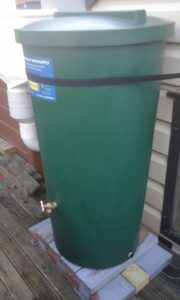Rainwater Tanks – for Emergencies & General Purposes
Craig has just installed a rainwater tank at the back of our house. It will save us the tedious task of washing and filling numerous bottles of water each year for emergencies as we now have 200 litres of stored water. It’ll be handy for watering the garden too and our boys will enjoy having water to use right by their play garden.
How do Rainwater Tanks Work?
Once the rainwater tank and supplied fittings are installed, rainwater travels off your roof, into your spouting, down your downpipe, through a diverter and into the tank. Near the base of the tank is a hose tap through which water can be accessed.
Using the Rainwater Tank Supply for Emergency Drinking Water
When using water from the rainwater tank to drink, the usual precautions are recommended – either boil the water or add a few drops of household bleach. Our tank holds 200l of water, giving us well over the advised 3 days’ worth of emergency water for each member of the family. The tanks can be strapped to protect your water supply in earthquakes.
Where Can I get a Rainwater Tank?
We got our rainwater tank from the Wellington City Council service centre for $105. It came with the necessary fittings for a regular install. Ours was a bit complicated and required Craig to use some extra plumbing know-how and fittings but most tanks should be straight-forward to install. The WCC tanks come in two colours – light brown and dark green. Some plumbing and building merchants sell them but we found it reassuring that these ones are endorsed by the council and they are well-priced.
Craig is keen to help others get prepared for emergencies by installing rainwater tanks. For a usual, straight-forward install, he can get yours up-and-running within a couple of hours.
Be prepared,
Craig & Julie



 Welcome to our Plumb blog! Establishing this blog is one of the final steps of many we’ve taken towards updating the profile of our residential plumbing and drainage business. Previously trading as RH Plumbing & Tiling Ltd, it was time to modernise our brand with a memorable name and logo and an online presence.
Welcome to our Plumb blog! Establishing this blog is one of the final steps of many we’ve taken towards updating the profile of our residential plumbing and drainage business. Previously trading as RH Plumbing & Tiling Ltd, it was time to modernise our brand with a memorable name and logo and an online presence.